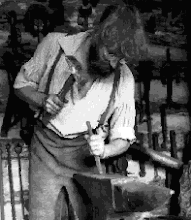As part of my recent attempt to (somewhat?) re-integrate into the Ontario (Eldormere) branch of the Society for Creative Anachronism (1) I will be mounting a bloomery iron smelt, assisted by other members of the Dark Ages Re-Creation Company.
This will take place over Friday through Sunday, June 21 - 23, at the 'Baron's Brouhaha' camping event, near Tiverton (Grey County) : https://ealdormere.ca/canton-of-northgeatham/barons-brouhaha/ With the full iron smelt happening all day Saturday June 22
 |
| Finished build - Smelt 85 'Bones' - June 2020 |
The Build - Will be similar to the the standard 'short shaft' used for Smelt 85 :
• clay build, mix of EPK dry clay with pulverized furnace wall material (from Smelt 94)
• set on shallow plinth of stone blocks
• base of charcoal fines, about 10 cm
• 25 cm ID / 60 - 65 cm total shaft height
• tuyere of ceramic tube, 2 cm ID
• set to 15 - 20 cm above fines, at 22 degrees down angle, 5 cm beyond interior wall
• estimated working stack height at 45 cm
• extraction arch at roughly 20 w x 10 h cm
• tapping arch at roughly 10 w x 5 h cm
The furnace will be constructed from late morning to mid day Friday. Gentle drying fire into that evening.
Test One : The use of pulverized wall material from a previously fired furnace mixed (roughly) 50/50 with fresh clay. Normally fresh material has been used for new builds, the standard mix being thirds by volume of powdered clay, course sand, and shredded horse manure. A mix using old furnace walls is the normal method used by Lee Sauder, who has excellent results, but this is the first time for our team. The expectation is some additional care needed during the initial drying stage.
 |
| Air set up - Smelt 90 'Wind & Weather' - October 2021 |
Air Supply - Will be similar to the arrangement used for Smelt 90, which will pair both a theoretical Norse twin bellows (enlarged for smelting) with an electric blower. This will allow alternately allowing individuals to use the bellows equipment, enabling comparison with mechanically delivered air. The bellows used had been created for the 'Vinland' series of experiments, at to date has provided air for 6 previous smelts. (2)
 |
| Sliding Air Gate, closed position |
The air delivered from the electric compression blower will be modified by two gates. The first will be used to set the total volume of air delivered, which has been at least roughly calibrated for 100's of litres per minute. The second gate is a sliding one, designed (??) to mimic the kind of changing 'pulse' air delivery provided by the twin bellows seen above. On a repeat cycle of roughly once per second (rate is adjustable), the gate shifts from fully open to allowing only a smaller amount of air. The main distortion is that this mechanical system does not allow for any changes in delivered pressure, which is the case for the bellows method.
Experiment Two : The sliding gate / pulse air delivery had been previously tested in Smelt 94. The intent this time is to be able to directly compare and measure the delivery from both the mechanical system and the twin bellows within the same smelting process. Past problems with instruments has meant that attempts to generate absolute numbers have been inconsistent. This test should at least be able to provide relative measurements between the two air methods, so allow for correct adjustments of the mechanical systems to the human operated bellows.
 |
| Richard Schweitzer operating the bellows - Smelt 44 'Vinland 5' at L'Anse aux Meadows HSC |
There will be some opportunity for observers to directly participate :
• A limited number of people can be directly involved as the working team. This can include both maintaining charcoal and ore ore additions to the furnace (two jobs).
• Throughout the smelt, large quantities of charcoal need to be broken and graded to size. Although certainly a messy task, this is something well suited to younger helpers.
• Individuals can take a turn operating the bellows. This normally undertaken on a five minute rotation.
• At the final extraction, a small group of dedicated hammer workers are required. Preference will be to those who have some related (blacksmithing) experience with sledge hammers.
 |
| First compaction of a bloom, well after dark - Smelt 87 '65 for 65', October 2020 |
It is expected that the use of the kind of air volumes indicated by the bellows will greatly increase the time per individual charcoal charge burning time, so extend the time required for the smelting process. (Smelt 94 required a total of 14 hours from initial pre-heat to final extraction)
This will be only the third time a full iron smelt has been undertaken at an SCA event in Eldormere. The working team from DARC to date has undertaken a total of 37 past smelts, the majority successfully resulting in iron blooms. For team leader Darrell Markewitz (aka Sylard of Eagleshaven) this will be his 95th.
Importantly, this is also a chance to see the process of experimental archaeology at work.
Notes :
1) My journey into Living History, so by extension, my independent creation of the Wareham Forge, and eventually research into bloomery iron smelting, all started with an accidental discovery of the very first SCA event in Ontario while an art student in 1976. By 2000 I had shifted my activities to the more specifically focused DARC.
2) For a commentary on previous use of various human powered air systems, see : Iron Smelting with Human Power




















